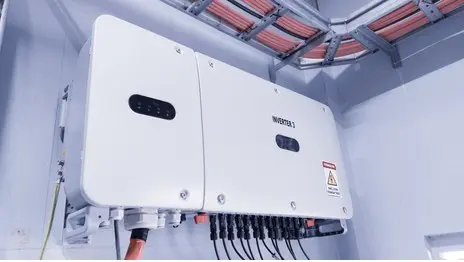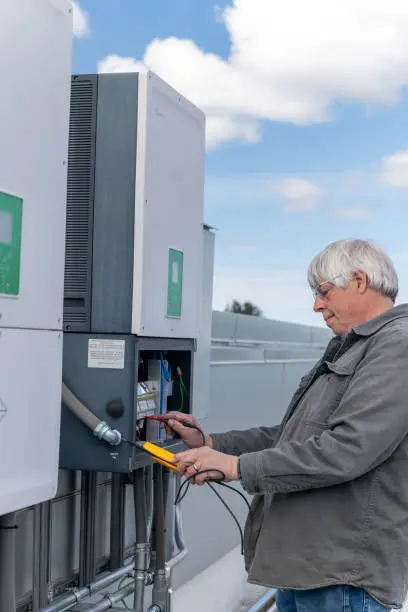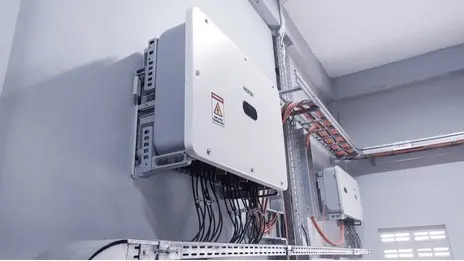If you're just starting to explore solar power, chances are you've heard the term thrown around: solar inverter. But what is a solar inverter—and why does every solar system need one?
Here's a clue: without a solar inverter, all of those shiny panels on your roof—or on a solar container—wouldn't power so much as a coffee brewer.
Let's take a brief overview of what a solar inverter does, how it works, the types available, and why choosing the right one is more vital than you might think.
Learning the Basics: What Is a Solar Inverter?
A solar inverter is essentially a device that converts DC (direct current) electricity—the electricity your solar panels generate—into AC (alternating current) electricity, which is what your home, business, or off-grid system actually operates on.
Without an inverter, none of the solar electricity your system generates would be usable by your lights, appliances, or equipment.
So, in a sense, the inverter is the "translator" between your solar panels and the devices that use the power.
Why Can’t We Just Use Solar Power As-Is?
Good question. Solar panels output DC electricity because it's simpler and more efficient for them to produce it that way. But the majority of modern systems—whether powering homes, offices, or mobile units—are based on AC.
Why AC?
- Easier to transmit over long distances
- Suitable for practically all conventional electronics
- Better adapted to synchronization with the grid and inclusion with batteries
That's why your inverter is so important—it bridges this gap perfectly, converting DC to AC in real time.

What Does a Solar Inverter Do Besides Convert?
Solar inverters these days are not just simple converters—they're smart hubs that manage your energy.
Here's what they typically do:
- MPPT Tracking (Maximum Power Point Tracking): Maximizes panel performance
- Grid or system synchronization: Adjusts voltage and frequency
- Data logging: Keeps track of performance and history
- System alerts: Identifies faults, temperature warnings, or shading loss
- Battery management: In hybrid or off-grid systems
Imagine your inverter as the nervous system of your solar system—it does translation, coordination, and protection.
Types of Solar Inverters
Depending on your installation—residential, commercial, mobile containerized—there are several types of inverters to accommodate different needs:
String Inverters
Common in typical residential systems. Panels are connected in series (a "string") to a single central inverter.
Pros: Cost-effective, old-school reliable
Cons: Single poorly performing panel reduces whole system output
Microinverters
Each panel has its own inverter.
Pros: Ideal for shaded roof or multiple orientation roofs
Cons: More costly, more complex wiring
Power Optimizers
Each panel is connected to a power optimizer, which talks to one central inverter.
Pros: More efficient than string-only systems
Cons: Still relies on health of central inverter
Hybrid Inverters
Inverter and battery controller integrated into single device.
Pros: Great for solar containers, remote/off-grid use, backup power
Cons: A little more complex, higher upfront cost
Real-World Example: Choosing the Perfect Inverter for a Solar Container
Imagine you're outfitting a solar container to a remote construction site. The unit has foldable solar panels and lithium batteries preinstalled—but you have your choice of inverter.
You can choose from two:
- A typical string inverter, designed primarily for grid-connected rooftop systems
- A hybrid inverter, designed specifically for off-grid use with built-in battery management
The project requires 24/7 power for generators, lights, and intermittent satellite communications. Grid availability? Zero.
The string inverter group soon found themselves with issues—battery charging was a failure, and the system was unable to assign higher-priority loads. Another site running on a hybrid inverter ran smoothly, with auto-switching between solar and battery, and real-time load management via EMS.
In solar container installations, inverter selection directly impacts reliability, efficiency, and system autonomy. The wrong inverter can be the system bottleneck in an otherwise high-power setup.

Trends to Watch: Smart Inverters and Grid Interactivity
In 2025 and later, inverters aren't just making solar possible—they're revolutionizing energy systems. Here's what's trending:
- Smart inverters with remote monitoring via Wi-Fi or 4G
- Virtual Power Plant (VPP) integration
- Dynamic reactive power for grid services
- AI-driven diagnostics for predictive maintenance
For solar containers in particular, these capabilities make mobile systems far more intelligent, responsive, and scalable.
Questions to Ask Before Buying a Solar Inverter
Before making a decision, ask:
- What’s the inverter’s conversion efficiency (aim for ≥97%)?
- Is it compatible with your battery chemistry?
- Does it support remote monitoring and firmware updates?
- What kind of warranty and support does the manufacturer provide?
- Is it designed for stationary or mobile deployment?

